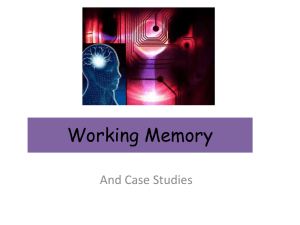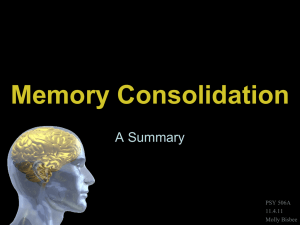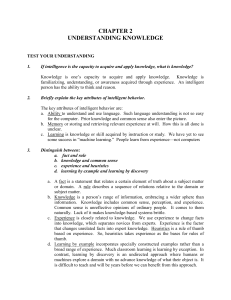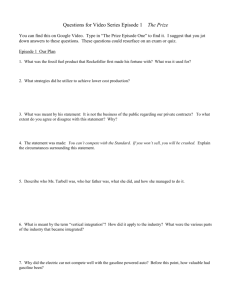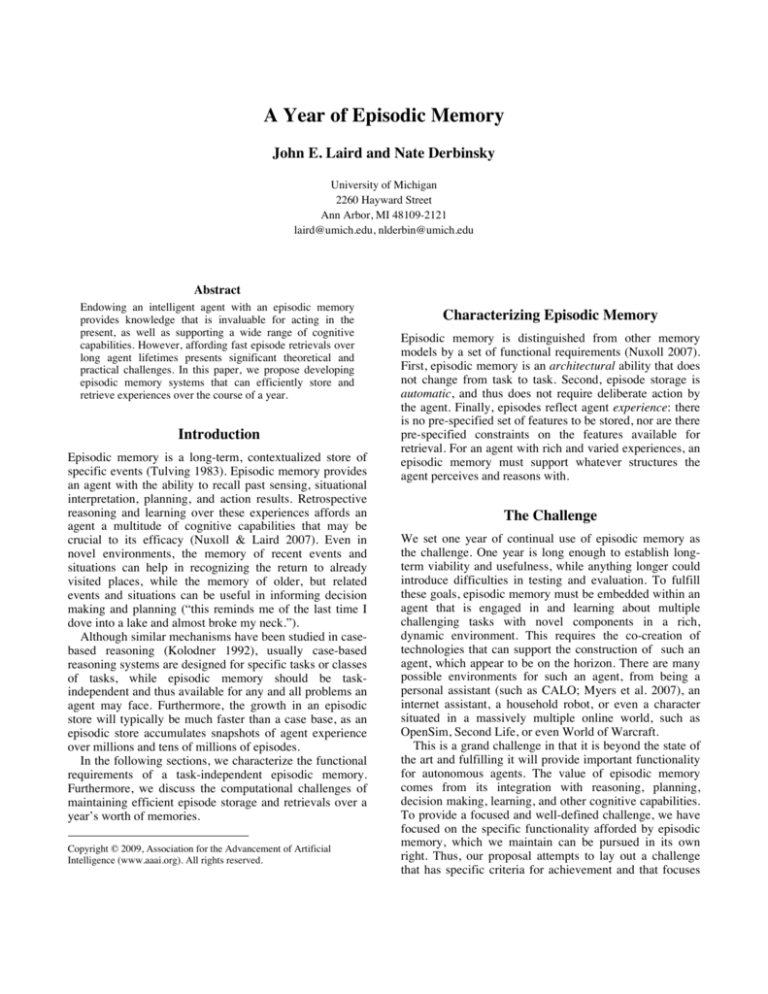
A Year of Episodic Memory
John E. Laird and Nate Derbinsky
University of Michigan
2260 Hayward Street
Ann Arbor, MI 48109-2121
laird@umich.edu, nlderbin@umich.edu
Abstract
Endowing an intelligent agent with an episodic memory
provides knowledge that is invaluable for acting in the
present, as well as supporting a wide range of cognitive
capabilities. However, affording fast episode retrievals over
long agent lifetimes presents significant theoretical and
practical challenges. In this paper, we propose developing
episodic memory systems that can efficiently store and
retrieve experiences over the course of a year.
Introduction
Episodic memory is a long-term, contextualized store of
specific events (Tulving 1983). Episodic memory provides
an agent with the ability to recall past sensing, situational
interpretation, planning, and action results. Retrospective
reasoning and learning over these experiences affords an
agent a multitude of cognitive capabilities that may be
crucial to its efficacy (Nuxoll & Laird 2007). Even in
novel environments, the memory of recent events and
situations can help in recognizing the return to already
visited places, while the memory of older, but related
events and situations can be useful in informing decision
making and planning (“this reminds me of the last time I
dove into a lake and almost broke my neck.”).
Although similar mechanisms have been studied in casebased reasoning (Kolodner 1992), usually case-based
reasoning systems are designed for specific tasks or classes
of tasks, while episodic memory should be taskindependent and thus available for any and all problems an
agent may face. Furthermore, the growth in an episodic
store will typically be much faster than a case base, as an
episodic store accumulates snapshots of agent experience
over millions and tens of millions of episodes.
In the following sections, we characterize the functional
requirements of a task-independent episodic memory.
Furthermore, we discuss the computational challenges of
maintaining efficient episode storage and retrievals over a
year’s worth of memories.
Copyright © 2009, Association for the Advancement of Artificial
Intelligence (www.aaai.org). All rights reserved.
Characterizing Episodic Memory
Episodic memory is distinguished from other memory
models by a set of functional requirements (Nuxoll 2007).
First, episodic memory is an architectural ability that does
not change from task to task. Second, episode storage is
automatic, and thus does not require deliberate action by
the agent. Finally, episodes reflect agent experience: there
is no pre-specified set of features to be stored, nor are there
pre-specified constraints on the features available for
retrieval. For an agent with rich and varied experiences, an
episodic memory must support whatever structures the
agent perceives and reasons with.
The Challenge
We set one year of continual use of episodic memory as
the challenge. One year is long enough to establish longterm viability and usefulness, while anything longer could
introduce difficulties in testing and evaluation. To fulfill
these goals, episodic memory must be embedded within an
agent that is engaged in and learning about multiple
challenging tasks with novel components in a rich,
dynamic environment. This requires the co-creation of
technologies that can support the construction of such an
agent, which appear to be on the horizon. There are many
possible environments for such an agent, from being a
personal assistant (such as CALO; Myers et al. 2007), an
internet assistant, a household robot, or even a character
situated in a massively multiple online world, such as
OpenSim, Second Life, or even World of Warcraft.
This is a grand challenge in that it is beyond the state of
the art and fulfilling it will provide important functionality
for autonomous agents. The value of episodic memory
comes from its integration with reasoning, planning,
decision making, learning, and other cognitive capabilities.
To provide a focused and well-defined challenge, we have
focused on the specific functionality afforded by episodic
memory, which we maintain can be pursued in its own
right. Thus, our proposal attempts to lay out a challenge
that has specific criteria for achievement and that focuses
on specific functional capabilities related to storing,
maintaining and retrieving experiences.
Efficiency Issues
The challenge of creating an episodic memory for an agent
that exists for a year arises from the real-time constraints
on the agent’s decision making in a complex, dynamic
environment. For episodic memory to be useful, episodic
storage and retrievals must not interfere with the agent’s
ability to respond to the dynamics of the environment –
relevant information must be available quickly enough for
it to be useful, even in a dynamic environment.
Furthermore, real-world agents face bounded storage:
while relatively cheap and plentiful, memory is not
unlimited.
Below we decompose the computational challenges
facing a task-independent episodic memory system into
encoding, storage and retrieval. Before jumping into the
analysis, we observe that in a year, a human is awake
approximately 21 million seconds (assuming 16 hours of
waking activity). Although this number seems small when
compared to gigabytes of memory and gigahertz of
processing cycles, for an ongoing agent with a non-trivial
amount of distinctive data in its short-term memories, these
numbers provide a significant challenge.
Encoding
Encoding involves the storage of volatile data from an
agent’s short-term memory into the long-term, persistent
episodic store. It involves determining when to store an
episode (episode initiation), what aspects of the current
situation should be stored, and how it is represented
(episode determination).
Episode Initiation. Frequency of episode storage, with
respect to agent lifetime, directly determines the number of
episodes. Broadly, more episodes provides the agent with a
finer-grain history of its experiences, but also implies more
data to process in the store, and thus greater challenges to
achieving system efficiency.
To fully reflect an agent’s experiences, an episodic
memory system must capture all structural and feature
changes that have taken place since the last recorded
episode. In the worst case, environmental changes are
dramatic and an episode must reproduce all
structure/features. Frequency of episode initiation, with
respect to agent lifetime, is a linear multiplier of this cost.
In situations of frequent storage, efficient systems must
attempt to identify and exploit data regularities, so as to
reduce redundancy, both in time and space, of stored
episodic data. Here we briefly discuss structural and
temporal regularities.
To facilitate reasoning and achieve productive behavior
in data-rich environments, intelligent agents must exploit
structural data regularities across time and tasks. Episodic
memory systems that recognize and adapt to these
regularities can expend less storage and time recording
data that is common across many episodes.
In real-world environments, features tend to change
slowly and locally. Episodic memory systems that process
only feature changes can realize dramatic performance
gains by focusing computation on important changes, as
opposed to static features (Nuxoll & Laird 2007).
Although it is unlikely there is one universal frequency
of episode storage that applies to all agents and all tasks,
we can get some indication of upper and lower bounds
from human cognitive processing. For humans, the basic
“cycle time” of deliberate behavior is on the order of 50ms.
That provides an upper bound on the amount of episodic
memory that must be stored in a year of 20 * 21 million
episodes = 420 million. It is difficult to determine a lower
bound, at least for humans, as on internal reflection it
seems that the resolution of our episodic memory is
significantly coarser – except for intense experiences. Our
own experience with mobile robots falls somewhere
between 2 and 10 episodes/second, which translates to
between 42 million and 210 million episodes for a year.
These numbers also provide a limit as to how much
processing is required in storing an episode. If we assume
the availability of a dedicated processor for episodic
memory, then it is well within the realm of today’s
processors to process between 1 and 20 episodes/second
(under the assumptions of episode content laid out in the
next section).
Episode Determination. In addition to the number of
stored episodes, the contents of each episode can pose
significant performance challenges. Here we consider the
implications of episode size, its representation, as well as
memory element distinctiveness.
In a rich environment, an agent will need to maintain a
potentially large representation of the current situation.
Clearly the larger the representation, the larger the storage
requirements and the higher the computational cost of
determining the appropriate episode during retrieval. This
is one area that is wide open in terms of estimating upper
and lower bounds. Attempting to base a lower-bound on
the famous 7+/-2 size of human short-term memory (Miller
1956) is fraught with error as those results were based on
memory tests of lists of items of similar “types,” which did
not take into account the human ability to remember rich
representations when items have rich semantic content and
distinctiveness. Episodes appear to capture rich
representations of situations that require 10’s and 100’s or
even 1,000’s of elements in current computer models. Our
own experience with episodic memory for non-toy tasks is
that somewhere between 100 and 1,000 elements are
required per episode.
Real-world environments contain rich relational feature
descriptions and thus agent episodes must be sufficiently
expressive to represent arbitrarily complex structures.
Thus, we impose the requirement that the underlying
representation cannot be merely propositional, but must
support relational representations. This level of
expressiveness, however, can introduce significant
performance challenges in the context of efficient storage
and retrieval, such as tracking feature changes, indexing
episodes for efficient retrievals, and reconstruction of
episodes for agent use. An open question is whether nonsymbolic representations are also required, such as images
or other perception-based representations.
In any representation, an episodic memory system must
contend with the spectrum of feature distinctiveness. At
one extreme is the problem of efficiently storing and
searching episodes containing many qualitatively different
features. For instance, consider searching over continuous
sensor features in a robotics domain. Episodic memory
systems in these domains must evaluate policies amongst
efficient, but ineffective, qualitative matches and
informative, but potentially costly, quantitative search
(Stottler et al. 1989).
Real-world environments also challenge episodic
memory systems with sets of qualitatively identical
objects. Object identification can vastly reduce storage
requirements by recognizing and compressing redundant
object descriptors, but at the cost of computationally
expensive comparison algorithms. A common approach
during retrieval is a two-stage matching algorithm
(Gentner & Forbus 1991; Tecuci & Porter 2007), bounding
expensive search operations over a small/constant number
of candidate episodes.
Storage
Episode Structure. The simplest and most expensive
model of episodic memory is to store a distinct snapshot in
each cognitive cycle. Based on our earlier worst-case
analysis, this would translate to one episode (1,000
elements) every 50ms (20 times/second) for 1 year (21
million seconds), which equals 420 billion items. Our bestcase scenario would be one episode (100 elements) every
500ms (2 times/second) for 1 year (21 million seconds),
which equals 4.2 billion items. There is an additional
multiplier for representing an item, which we estimate to
be between 10 and 100 bytes, giving a range of memory
requirements of between 42 GB and 42 TB.
More sophisticated approaches to encoding episodes,
such as taking advantage of temporal continuity and
redundant structures, can decrease these demands, at the
cost of additional indexing. In our work, we have seen a
minimum of a factor of 2 decrease from compression.
Thus, a reasonable estimate is between 21 GB and 21 TB
using current approaches. Both of these are within range of
today’s commodity secondary storage systems. The lower
end of the range is possible with primary memory for
servers, which appear to have a current practical limit of
256 GB. This analysis suggests that memory alone is
probably not a limiting factor for achieving year-long
episodic memory.
Episode Dynamics. The continued growth of episodes
introduces computational challenges both in the amount of
memory for storage and the computational resources
required for retrieval. To decrease the growth or even
bound the size of the episodic store, a forgetting or
consolidation mechanism could be introduced. Such a
mechanism could maintain statistics about the episodic
store (retrieval frequency, age, usefulness, redundancy, etc)
and, upon reaching maximum capacity, make a decision
about which episode(s)/episode feature(s) to remove or
consolidate. An important issue is whether the gain in
computational performance through forgetting outweighs
the potential negative impact on reasoning that arises from
the loss of episodes that could be useful in future
reasoning.
Retrieval
Retrieving a memory involves matching a cue against the
stored episodes, determining a best match, and
reconstructing the episode so it can be used in reasoning.
Cue matching over a growing episodic store has the
potential to be the most costly episodic operation as a
complete search of the store is at least linear in the number
of episodes, and because the episodes have complex
relational structures.
Moreover, the frequency of retrievals and source of
retrieval cues can significantly affect the computational
cost of the implementation. For instance, supporting
spontaneous cues (i.e. episodic retrieval over the entirety of
the present state) demands an implementation that is
continually searching episodic memory using cues with
relatively large numbers of features. Although spontaneous
retrieval is potentially beneficial, we take as a starting
point for this challenge that retrieval is based on
deliberately constructed cues that are significantly smaller
than individual episodes.
Within the context of a broader agent, a retrieval does
not necessarily have to be tied directly to the time scale of
primitive deliberation. In humans, an episodic retrieval can
be on a time scale of many primitive cycles (50 ms).
However, a memory will lose its utility if it has not been
retrieved within some limited amount of time after cue
initiation. Clearly this depends on the dynamics of the task.
To give a ballpark figure, we will assume 1 second, which
corresponds to 20 primitive cycles. We also assume that a
retrieval can be executed asynchronously using its own
processing resources, making 1 second a fixed bound.
Consider a linear search of the best case for a year’s
worth of memories (21 GB) stored sequentially in [an
extended] primary memory given modern hardware (2GHz
CPU). Ideal conditions would require at least 10 seconds
for the processor to read every memory element. This
estimate will increase by multiple orders of magnitude
when search comparisons are taken into account. And this
is the best case with the worst case requiring 1,000 times as
much data to be processed.
This defines the real challenge: how to organize episodic
data, as it is learned over a year, so that it can be searched
in bounded time. There are two basic approaches. The first
is to develop algorithms and data structures that speed the
matching processes but still guarantee a best match.
Although these could potentially achieve high performance
in the average case, in the worst case they must examine
every episode; however, with massive parallel processing,
it might be possible to still achieve the requisite reactivity.
An alternative is to develop heuristic approaches that no
longer guarantee a best match, but can provide guaranteed
performance (possibly through an anytime algorithm).
Some possible approaches include history compression
(Schmidhuber 1992) and query caching/optimization
(Chaudhuri 1998; Gupta et al. 1997). If this challenge is
accepted, it will be necessary not only to define
computational performance requirements, but also metrics
for assessing the quality of the retrieved episodes.
Conclusions
Prior work has shown that endowing an agent with an
episodic memory provides knowledge to support a vast
array of cognitive abilities crucial for intelligent behavior.
We have proposed the challenge of developing episodic
memory systems that can capture the experience of an
agent that exists for a year and runs in real time. We have
attempted to provide bounds on the computational
resources required for such a system. These are very broad,
spanning multiple orders of magnitude and providing
answers that are more specific, unfortunately, awaits the
development of agents that actually exist for a year.
It appears that the computational resources required to
encode and store the resulting episodes are within reach.
Developing algorithms that can support sufficiently fast
bounded retrievals is the real challenge. Meeting that
challenge will involve drawing on recent work in large
scale relational databases, but given the open-endedness of
the structures that must be stored, the challenge will
require significant extensions to existing work. In addition
to research in data structures and algorithms, we foresee a
considerable need for empirical evaluation across a range
of tasks and environments. We surmise that these
performance benchmarks will draw on and contribute to a
variety of experienced-based reasoning research.
References
Chaudhuri, S. 1998. An Overview of Query Optimization in
Relational Systems. In Proceedings of the 17th ACM
SIGACT-SIGMOD-SIGART Symposium on Principles of
Database Systems, 34-43.
Gentner, D., Forbus, K.D. 1991. MAC/FAC: A Model of
Similarity-based Retrieval. In Proceedings of the 13th
Cognitive Science Conference, 504-509.
Gupta, H., Harinarayan, V., Rajaraman, A., Ullman, J.D.
1997. Index Selection for OLAP. Conference on Data
Engineering, 208-219.
Kolodner, J. 1992. An Introduction to Case-Based
Reasoning. Artificial Intelligence Review, 6(1): 3-34.
Miller, G.A. 1956. The Magical Number Seven, Plus or
Minus Two. The Psychological Review 63(2): 81-97.
Myers, K., Berry, P., Blythe, J., Conley, K., Gervasio, M.,
McGuinness, D., Morley, D., Pfeffer, A., Pollack, M., and
Tambe, M. 2007, An Intelligent Personal Assistant for
Task and Time Management, AI Magazine, 28(2):47-61.
Nuxoll, A. 2007. Enhancing Intelligent Agents with
Episodic Memory. Ph.D. diss., Univ. of Michigan, Ann
Arbor.
Nuxoll, A., Laird, J.E. 2007. Extending Cognitive
Architecture with Episodic Memory. In Proceedings of the
21st National Conference on Artificial Intelligence, 15601564.
OpenSim, http://opensimulator.org
Schmidhuber, J. 1992. Learning Complex, Extended
Sequences Using the Principle of History Compression.
Neural Computation, 4(2), 234-242, MIT Press.
Second Life, http://secondlife.com
Stottler, R., Henke, A., King, J. 1989. Rapid Retrieval
Algorithms for Case-Based Reasoning. In Proceedings of
the Eleventh International Joint Conference on Artificial
Intelligence, 233-237.
Tecuci, D., Porter, B. 2007. A Generic Memory Module for
Events. In Proceedings of the Twentieth International
FLAIRS Conference, 152-157.
Tulving, E. 1983. Elements of Episodic Memory. Oxford:
Clarenden Press.
World of Warcraft, http://www.worldofwarcraft.com

